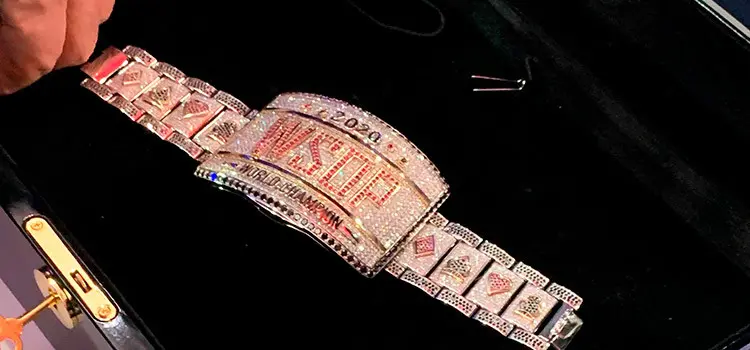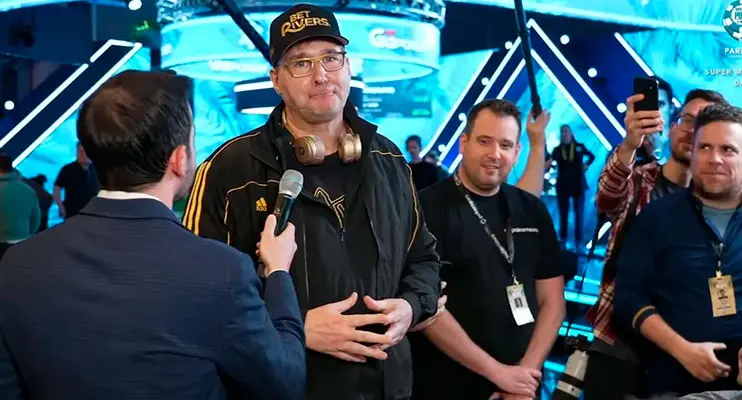- Home
- Latest poker news
- Bracelet Inflation: What's Happening to the WSOP's Top Prize?
Bracelet Inflation: What's Happening to the WSOP's Top Prize?
Phil Hellmuth has once again stirred up controversy surrounding the WSOP again. This time, he claimed that bracelets are losing value and should be awarded much less. Many players have rightly noted that, under current conditions, significantly reducing the number of bracelets is impossible. Daniel Negreanu called for a solution that avoids drastic measures and acknowledged that GGPoker and WSOP management are already discussing it.
What are Hellmuth and Negreanu saying?
After the controversy surrounding the PoY, where Phil's main opponent was Shaun Deeb, died down, "PokerBrat" has been talking more and more about the value of WSOP bracelets.
He says the biggest frustration in the U.S. live poker community is the surge in bracelets. He believes the series has "run out of steam" and that the trophy's prestige needs to be salvaged. On air on the No Gamble No Future show, he said:
"I've already said publicly: there should be a maximum of about 100 bracelets a year—50 in Vegas in the summer, 10 in the Bahamas, 10 in Europe, 10 in Asia, and 20 online. Now there are many more, and that's killing the very idea of the trophy."
He was also blunt in criticizing online events. If bracelets won there continue to have the same status as live tournament awards, he will stop playing the World Series altogether.
Phil’s arguments follow a familiar pattern: he sees himself as a guardian of the "WSOP legacy" and is willing to speak bluntly, sometimes too bluntly.
Daniel Negreanu took a softer tone, though he largely agrees. He responded:
"Yes, there are too many bracelets. We are indeed discussing reducing the number of bracelets per year, but I propose sticking with 150. Reduce it, but not to an extreme."
Daniel also noted that a significant reduction in the number of bracelets would hurt formats that are important to Hellmuth, including Razz and Mixed games.
Other prominent players have expressed their opinions on the issue:
- Jason Mercier worries that modern bracelets are often won in large-field tournaments with huge fields and simple structures rather than in battles with the elite.
- Erik Seidel believes that comparing old and current records is pointless: there are too many events. He says growth is normal, but a new system for measuring achievement is needed.
- Chris Ferguson proposes introducing "bracelet categories": distinguishing between top events, mass tournaments, rare formats, and online events. He believes that the difference between bracelets has always been intuitively felt by players, but it's time to formalize it.
Young players, on the other hand, see the "bracelet for everyone" idea as a logical step in the industry's development: poker has become a mass sport, and the symbol of victory should evolve along with it.
Why has the number of bracelets grown?

| Year | Bracelets in Vegas |
|---|---|
| 1970 | 1 |
| 1980 | 12 |
| 1990 | 15 |
| 2000 | 25 |
| 2010 | 57 |
| 2019 | 81 |
| 2024 | 99* |
*Total 245 bracelets.
WSOP history shows that an increase in bracelet events is almost inevitable. In the 1970s, the maximum number of bracelets was 12, and the series was niche. Then came the TV era, the online boom, and international expansion. During the pandemic, there was a sharp increase in online events—in 2019, there were only 9, but in 2024, there were 115.
Each wave of expansion split the audience into distinct groups:
- Events with a narrow but stable fan base;
- Large low-buy-in tournaments;
- High-roller tournaments with buy-ins in the tens and hundreds of thousands of dollars;
- Online tournaments.
The organizers tried to keep everyone involved, and the supply grew. From their perspective, growth means profit: more registrations, more buy-ins, more sponsors. But at the same time, the brand risks losing its identity. If a bracelet ceases to be a rarity, the WSOP could begin to be perceived as a tournament factory.
Possible Reform Scenarios

We have identified four possible scenarios:
- Radical Restructuring
- Moderate Reform
- Bracelet Hierarchy
- Dynamic Regulation
Hellmuth Option (Most Unlikely)
The WSOP could significantly reduce the number of live and online events, leaving a maximum of 100-120 bracelets per year.
This is the most drastic approach. It would restore the prestige of the most significant tournaments and make the title a rare prize once again, but at the same time, some formats, especially niche and mixed formats, could be eliminated as "unprofitable." The mass segment of online play could also suffer, and the series would lose some of its audience.
Negreanu Option
A compromise—Negreanu's proposal—is to retain more events than Hellmuth proposes, but reduce growth, impose limits on certain tournament categories, and perhaps even separate online events.
In this case, the World Series would retain its commercial profitability and mass appeal, while also slightly reducing "bracelet inflation." This approach would be less disruptive, but likely wouldn't completely eliminate criticism of the WSOP's devaluation of its prize.
Ferguson's Option
The most elegant and perhaps sustainable solution is the introduction of "bracelet tiers."
The WSOP could officially divide bracelets into categories: for example, "prestigious" (high buy-in, complex structures), "mass" (low buy-in, fast-paced tournaments), "rare formats," and "online bracelets."
This approach would preserve a large number of tournaments, but would also formalize the semantic differentiation that everyone currently feels, albeit in the form of informal expectations. Players would have a clearer understanding of which bracelet is worth more in terms of prestige, and the series would retain its flexibility and profitability.
Dynamic Regulation
The WSOP could introduce a dynamic policy: counting not just the number of bracelets but also the "weight" of tournaments. For example, analyzing attendance, player level, structure, and poker type, and using this data to adjust the bracelet "quota."
This is a complex model, and the actual ranking of bracelet significance could then become similar to the levels in a loyalty program, from, say, "Iron" to "Gold."
Conclusion
The dispute between Hellmuth and Negreanu is not just another disagreement between stars, but a sign of a deeper problem. The WSOP has grown to such a scale that the series' main symbol has started to lose some of its distinctiveness.
Hellmuth emphasizes tradition and rarity, Negreanu talks about balance, and other professionals emphasize the importance of structure, field strength, and the weight of individual events.
There are many solutions, each with its pros and cons. But one thing is clear: the WSOP faces a choice. Whether the bracelet will retain its status as a mark of the elite or become a common element of a major tournament brand depends on both the series' prestige and its future positioning.
Former history and English teacher Harald Sammer made an impressive comeback at the WSOP Circuit ...
On October 9, 2025, the new WSOP Europe Main Event champion was announced: German businessman Dan...
The WSOPE has been held at King's Casino in Rozvadov, Czech Republic, for eight years. But in 202...
The World Series of Poker (WSOP) continues to actively develop the media space around its tournam...

